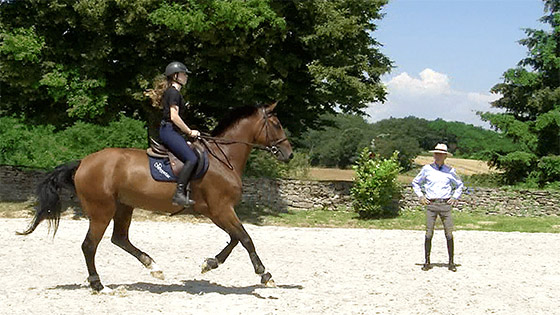Varying the length of the canter stride, placing the correct stride approaching a jump

This schooling grid allows the rider to experiment with the different options in the canter stride to get the correct place for the perfect take-off stride.
This schooling grid allows the rider to experiment with different options of the canter stride to get the correct place for the take-off stride. As we’ll see, it is easier to place the stride correctly if we approach this grid with the same canter repeatedly, thus the bounce on the way-in for a first canter stride properly placed in the grid. The goal is to avoid influencing the horse with the hand or leg aids to allow the horse as much freedom as possible when he gets close to the jump at the end of the line and over the jump.
The set-up starts with 4 normal strides with a normal distance which allows the rider and the horse to gain confidence including green horses as it is the case in the video. The rider can easily set the good ingredients for a good jump by perfecting her wide angle view and a position that is consistent with the control and relaxation we’re seeking. Remember that 90% of the distance issues when jumping, take root in the rider’s mind. As seen many times, as soon as the doubt or fear arises, the rider’s body gets stiff, the eyes look down and the position worsen which results in a negative impact on the horse locomotion and mind. In such conditions, it is indeed challenging to have a good place. Thus the benefits of riding these kind of grids to implement confidence. Only when the rider is able to ride in a relaxed and loosened position, will the rider be able to influence the canter stride of the horse to place the horse correctly.
This exercise is linked to the sheet OBS2 of the booklet Training program 1
The rider has to ride the same number of strides on a distance that we will reduce or lengthen by about 1 meter. The height and jump’s profile will be adapted to the capability of the rider and/or horse. The priority is given to keeping a wide angle view and to the rider’s position that should stay the same whatever the length of stride of the horse. A 3-point light seat or a 2 point light seat will allow the rider to follow the motion of the jump easily.
